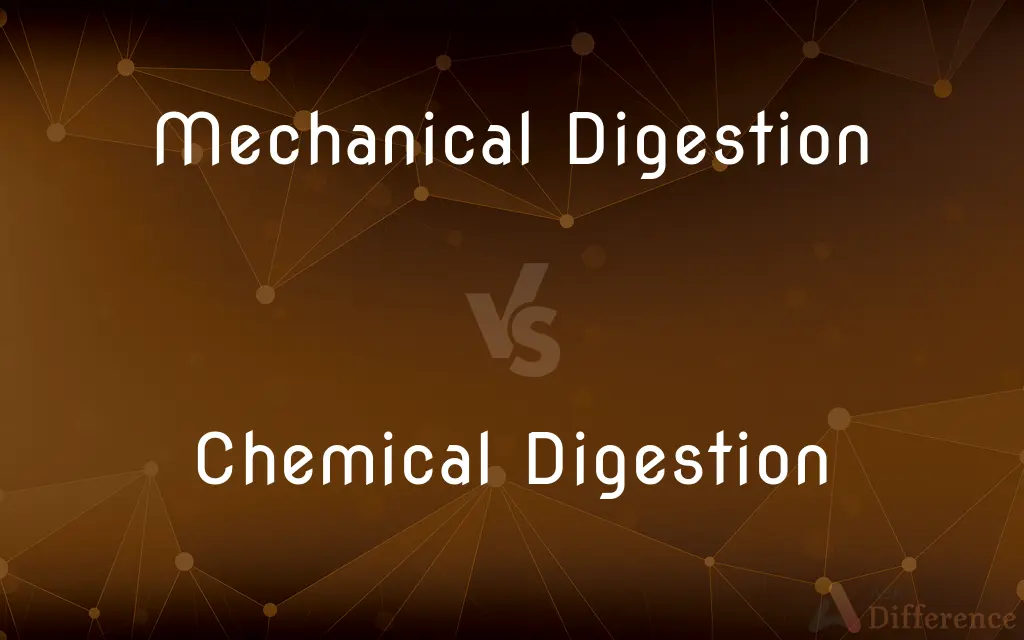Mechanical Digestion vs. Chemical Digestion — What's the Difference?
By Fiza Rafique — Published on December 11, 2023
Mechanical Digestion physically breaks down food; Chemical Digestion uses enzymes to chemically break down nutrients.

Difference Between Mechanical Digestion and Chemical Digestion
Table of Contents
ADVERTISEMENT
Key Differences
Mechanical Digestion refers to the physical breakdown of large pieces of food into smaller particles. This process doesn't alter the chemical structure of the food. Chemical Digestion, on the other hand, involves the breakdown of food by enzymatic reactions, changing its molecular structure and releasing nutrients.
In Mechanical Digestion, actions like chewing and the churning of the stomach are primary mechanisms. These actions increase the surface area of the food, making it more accessible for enzymes. Meanwhile, Chemical Digestion relies on specific enzymes that target different nutrients, breaking them down into simpler substances the body can absorb.
Both Mechanical Digestion and Chemical Digestion are essential for the efficient processing of food in the digestive system. While Mechanical Digestion commences in the mouth as food is chewed, Chemical Digestion starts in the mouth too but predominantly takes place in the stomach and small intestine where acids and enzymes act on the food.
Mechanical Digestion predominantly utilizes muscular actions, from the teeth grinding food to the muscular walls of the stomach churning its contents. In contrast, Chemical Digestion is about biochemical reactions. Enzymes, which are catalysts, speed up these reactions, ensuring food is broken down efficiently.
One notable difference is the end result. After Mechanical Digestion, the food's chemical composition remains unchanged, just fragmented. In Chemical Digestion, however, the molecular structure of the food is altered, transforming complex molecules into simpler ones ready for absorption.
ADVERTISEMENT
Comparison Chart
Nature
Physical process
Biochemical process
Initiation
Begins in the mouth with chewing
Begins in the mouth with salivary enzymes
Mechanism
Uses force and movement
Uses enzymes
Outcome
Breaks food into smaller pieces
Alters molecular structure of food
Predominant Locations
Mouth and stomach
Stomach and small intestine
Compare with Definitions
Mechanical Digestion
Mechanical Digestion primarily uses force and movement.
The action of teeth breaking down an apple is a clear instance of Mechanical Digestion.
Chemical Digestion
Chemical Digestion changes the food's molecular structure.
Carbohydrates are transformed into simple sugars during Chemical Digestion in the digestive tract.
Mechanical Digestion
Mechanical Digestion is the physical fragmentation of food into smaller bits.
Chewing bread in your mouth initiates Mechanical Digestion.
Chemical Digestion
Chemical Digestion is the enzymatic decomposition of food.
Salivary amylase kickstarts the Chemical Digestion of starch in the mouth.
Mechanical Digestion
Mechanical Digestion initiates the digestive process.
When you munch on a carrot, Mechanical Digestion begins the journey of digestion.
Chemical Digestion
Chemical Digestion is a biochemical process requiring specific enzymes.
The lactase enzyme facilitates the Chemical Digestion of lactose in dairy products.
Mechanical Digestion
Mechanical Digestion increases the surface area of food for enzymes.
The stomach's churning is part of Mechanical Digestion, making nutrients more accessible.
Chemical Digestion
Chemical Digestion releases nutrients ready for absorption.
Chemical Digestion in the intestines ensures fats are converted into fatty acids and glycerol.
Mechanical Digestion
Mechanical Digestion doesn't alter the food's chemical composition.
Grinding grains into flour involves Mechanical Digestion without changing their chemical nature.
Chemical Digestion
Chemical Digestion transforms complex molecules into simpler ones.
Proteins are broken down into amino acids through Chemical Digestion in the stomach.
Common Curiosities
Are enzymes involved in Chemical Digestion?
Yes, enzymes play a pivotal role in Chemical Digestion, breaking down complex food molecules.
How does Chemical Digestion differ from Mechanical Digestion?
Chemical Digestion uses enzymes to break down food's molecular structure, while Mechanical Digestion physically fragments food.
Is the food's chemistry altered during Mechanical Digestion?
No, Mechanical Digestion only changes the physical size of the food, not its chemical composition.
Where does Mechanical Digestion mainly occur?
Mechanical Digestion starts in the mouth with chewing and continues in the stomach with churning.
What is Mechanical Digestion?
Mechanical Digestion is the physical breakdown of food into smaller pieces without changing its chemistry.
Is the stomach involved in both Mechanical and Chemical Digestion?
Yes, the stomach participates in Mechanical Digestion through churning and in Chemical Digestion with gastric enzymes.
Which digestive process transforms proteins into amino acids?
Chemical Digestion breaks down proteins into amino acids.
Which digestion type ensures nutrients are ready for absorption?
Chemical Digestion breaks food into simpler molecules, preparing them for absorption.
Is force a significant component of Chemical Digestion?
No, Chemical Digestion relies on biochemical reactions, not physical force, which is central to Mechanical Digestion.
Are teeth involved in Chemical Digestion?
No, teeth are essential for Mechanical Digestion, physically breaking down food by chewing.
Can digestion occur without Mechanical Digestion?
While Mechanical Digestion aids in digestion, certain animals rely more on Chemical Digestion.
What initiates the Chemical Digestion of carbohydrates?
Salivary amylase in the mouth starts the Chemical Digestion of carbohydrates.
Do enzymes in Chemical Digestion act everywhere in the digestive tract?
Different enzymes act at specific locations, with most Chemical Digestion occurring in the stomach and small intestine.
Can Chemical Digestion start in the mouth?
Yes, the enzymatic action of salivary amylase begins Chemical Digestion of starches in the mouth.
Why is Mechanical Digestion important?
Mechanical Digestion increases food's surface area, making it more accessible for enzymatic action in Chemical Digestion.
Share Your Discovery

Previous Comparison
Dry Granulation vs. Wet Granulation
Next Comparison
Raw Sugar vs. Brown SugarAuthor Spotlight
Written by
Fiza RafiqueFiza Rafique is a skilled content writer at AskDifference.com, where she meticulously refines and enhances written pieces. Drawing from her vast editorial expertise, Fiza ensures clarity, accuracy, and precision in every article. Passionate about language, she continually seeks to elevate the quality of content for readers worldwide.
















































